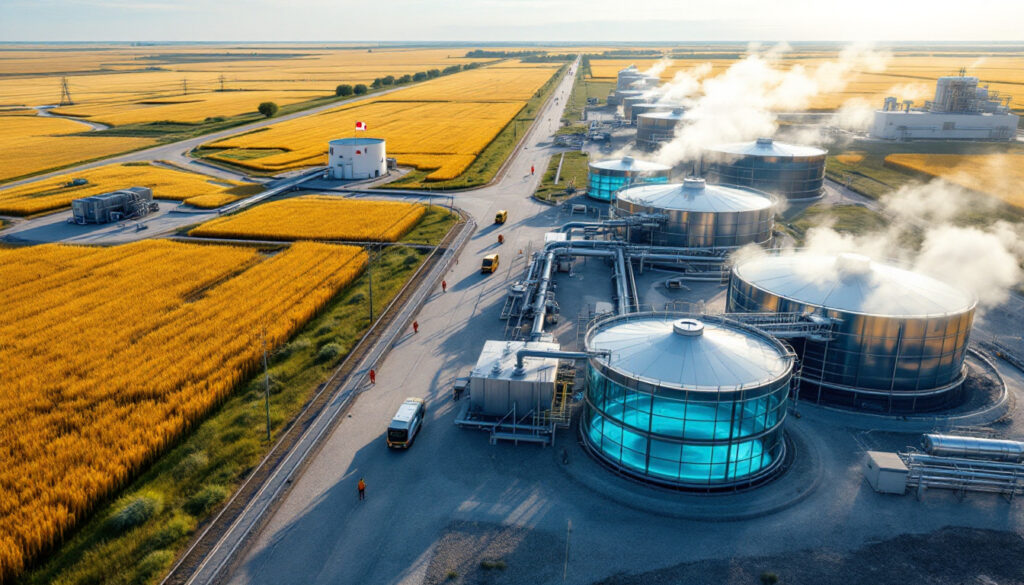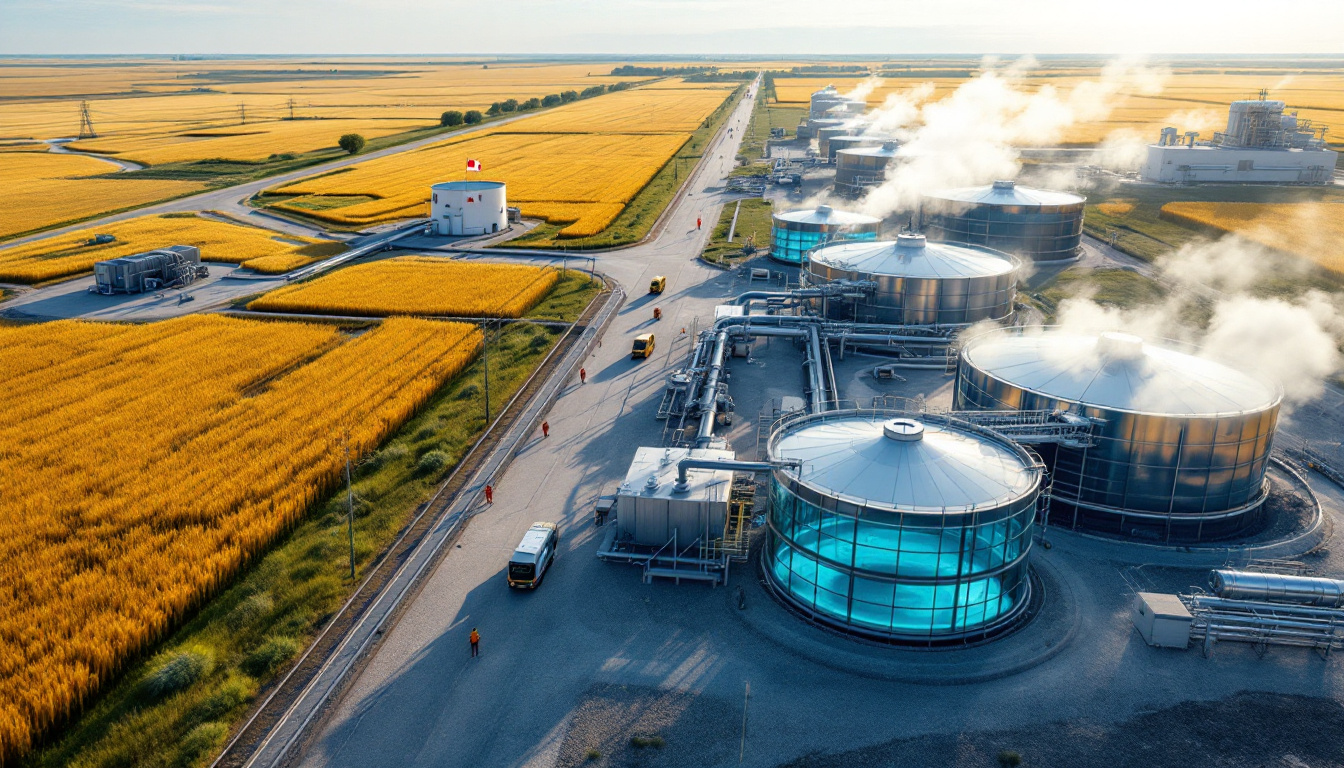What is Arizona Lithium's Prairie Project in Saskatchewan?
The Prairie Project, developed by Arizona Lithium (ASX:AZL), stands as one of North America's most promising lithium brine developments. Located in Saskatchewan's resource-rich Williston Basin, this groundbreaking initiative has earned the distinction of being the first lithium brine project in the province to receive production approval.
With a comprehensive resource base of 6.3 million tonnes of lithium carbonate equivalent (LCE) spread across 345,000 acres of mineral rights, Prairie represents a significant advancement in Canada's emerging lithium sector. The project's strategic location in the Williston Basin provides exceptional infrastructure advantages that many competing lithium brine market insights lack.
Prairie's development comes at a critical time as North America seeks to establish domestic supply chains for battery materials, reducing dependency on overseas sources and strengthening energy security across the continent.
How Did Prairie Become Saskatchewan's First Approved Lithium Production Project?
Regulatory Milestone Achievement
In a landmark decision, Saskatchewan's Ministry of Energy and Resources recently granted Arizona Lithium approval for Phase 1 production operations at the Prairie Project. This regulatory milestone established Prairie as the province's first lithium brine project to reach this development stage and positions it among North America's earliest approved lithium brine production facilities.
The approval followed a thorough yet efficient review process that balanced environmental considerations with economic development potential, showcasing Saskatchewan's commitment to responsible resource development.
Saskatchewan's Supportive Regulatory Framework
Saskatchewan has cultivated one of the most mining-friendly regulatory environments in North America, creating clear permitting pathways that enable projects to advance efficiently without sacrificing oversight quality. This balanced approach has proven particularly valuable for emerging sectors like lithium industry innovations.
"The regulatory framework in Saskatchewan provides a clear permitting path, allowing for swift but thorough evaluation of resource projects," noted Arizona Lithium Managing Director Paul Lloyd.
Over the past five years, Saskatchewan has made substantial lithium-focused investments, with government geological surveys identifying the southeastern region as hosting Canada's highest-grade lithium brines. This strategic focus has positioned the province to become a leader in North American lithium production.
Government Recognition of Strategic Importance
Saskatchewan officials have publicly acknowledged Prairie's leadership position in lithium resource and process development. Energy and Resources Minister Colleen Young expressed satisfaction with the project reaching this production milestone, stating:
"We're pleased to see the Prairie Project reach this important development stage. The project has been leading the charge in lithium resource and process development in our province."
Meanwhile, Trade and Export Development Minister Warren Kaeding highlighted how such investments contribute to broader economic and strategic goals, emphasizing the project's role in:
- Provincial capacity-building
- Job creation across technical and support sectors
- Enhancing global energy security
- Strengthening North American supply chains
This governmental support demonstrates the project's alignment with provincial economic development priorities and underscores the strategic importance of lithium resources in Saskatchewan's future.
What Production Capabilities Will Prairie Deliver?
Initial Production Specifications
The Phase 1 operations at Prairie will commence at 150 tonnes per annum (tpa) of lithium carbonate equivalent, utilizing a full commercial-scale Direct Lithium Extraction (DLE) unit. This initial production capacity provides Arizona Lithium with several strategic advantages:
- Demonstrating commercial viability at a manageable scale
- Allowing operational optimization before major expansion
- Generating early revenue while larger phases develop
- Reducing initial capital requirements
The modular approach to production enables sequential scaling through replication of the initial unit, offering flexibility in expansion timing and capital deployment.
Resource Expansion Through Updated Modeling
Recent drilling and completion activities conducted in 2024 have led to a significantly enhanced well network model that substantially expands the project's potential:
| Resource Metric | Previous Estimate | Updated Value | Percentage Increase |
|---|---|---|---|
| Annual Producible LCE | ~7,700 tpa | 17,000 tpa | 120% |
| Total Indicated Resource | ~3.0 Mt LCE | 4.6 Mt LCE | 53% |
| Overall Resource Base | ~5.7 Mt LCE | 6.3 Mt LCE | 11% |
These impressive resource increases resulted from advanced geological modeling techniques applied to new field data, validating the project's significant potential and providing a robust foundation for long-term development planning.
Operational DLE Technology
The Prairie Project currently hosts Saskatchewan's most advanced lithium extraction facility – an operational Koch Li-Pro direct lithium extraction pilot plant. This installation represents the largest DLE pilot ever deployed by Koch Technology Solutions, producing lithium chloride at approximately 150 tpa LCE.
The successful implementation of this technology demonstrates several key advantages:
- Process validation: Confirming DLE effectiveness with Prairie's specific brine chemistry
- Operational data collection: Gathering real-world performance metrics to optimize full-scale operations
- Technical risk reduction: Identifying and addressing challenges before larger capital deployment
- Stakeholder confidence: Providing tangible evidence of the project's viability
This technological implementation establishes Prairie as a proving ground for commercial-scale DLE technology in the Canadian context, potentially benefiting the broader North American lithium sector through knowledge advancement.
What Makes Prairie Strategically Valuable for North American Lithium Supply?
Premium Geographic Positioning
Prairie benefits tremendously from its location in Saskatchewan, consistently ranked among the world's most mining-friendly jurisdictions according to the Fraser Institute's annual survey. The Williston Basin setting provides exceptional infrastructure advantages that significantly reduce development costs and timelines:
- Electrical grid connectivity: Direct access to Saskatchewan's reliable power network
- Natural gas availability: Abundant energy supply for processing operations
- Freshwater resources: Secure water sources for operations
- Transportation advantages: Immediate access to paved highways and railroads
- Skilled workforce proximity: Access to experienced mining professionals and technical specialists
These infrastructure benefits stand in stark contrast to many competing lithium projects in more remote locations that require substantial investments in basic infrastructure before production can begin.
North American Supply Chain Significance
With global lithium demand projected to increase by 500% by 2050 according to the International Energy Agency (2023), Prairie is positioned to become a significant contributor to North American lithium supply security. This domestic production capability addresses critical needs for:
- Electric vehicle battery manufacturing: Supporting North America's rapidly expanding EV production
- Renewable energy storage systems: Enabling grid-scale deployment of wind and solar power
- Supply chain security: Reducing dependence on overseas lithium sources
- Geopolitical resilience: Diversifying supply beyond politically sensitive regions
"Investments like the Prairie Project are contributing to our province's capacity-building, creating jobs, and supporting global energy security," noted Trade and Export Development Minister Warren Kaeding.
The project's alignment with both Canadian and U.S. critical minerals strategies positions it favorably for potential government support and partnership opportunities with major battery manufacturers seeking domestic supply options.
Development Timeline Advantages
A comprehensive pre-feasibility study (PFS) is currently underway, with the project advancing at an accelerated pace compared to many competing lithium developments in North America. This rapid progress can be attributed to several factors:
- Saskatchewan's efficient regulatory framework
- The project's existing infrastructure advantages
- The proven DLE technology already operational on site
- The experienced technical team assembled by Arizona Lithium
The regulatory approvals represent what AZL Managing Director Paul Lloyd described as "another massive milestone in project development," underscoring the project's momentum and positioning it to potentially become one of North America's earliest new lithium producers.
What Technology is Driving Prairie's Development?
Direct Lithium Extraction Innovation
Prairie utilizes advanced Direct Lithium Extraction technology, specifically the Koch Li-Pro system, which offers several advantages over traditional lithium production methods:
| DLE Advantage | Comparison to Traditional Methods |
|---|---|
| Environmental Footprint | 90% smaller land disturbance vs. evaporation ponds |
| Production Timeline | Months vs. years for traditional methods |
| Water Consumption | Up to 90% reduction in freshwater usage |
| Recovery Efficiency | Typically 70-90% vs. 40-50% for evaporation |
| Climate Resilience | Weather-independent operation vs. climate-dependent evaporation |
The Koch Li-Pro system specifically employs advanced ion exchange technology that selectively captures lithium ions from brine while leaving most other elements in solution. This selective approach yields a higher-purity intermediate product that requires less downstream processing.
Note: The specific recovery rates achieved at Prairie will be verified during Phase 1 operations and reported in subsequent technical studies.
Scalable Production Model
The modular DLE approach enables incremental production scaling, allowing Arizona Lithium to implement a phased development strategy with several strategic benefits:
- Risk management: Begin commercial operations at manageable initial volumes
- Capital efficiency: Expand production capacity through replication of proven units
- Market responsiveness: Adjust development pace based on lithium market challenges
- Technical optimization: Incorporate learnings from each phase into subsequent expansion
This approach contrasts with the "all-or-nothing" development model often required for traditional lithium projects, where full-scale infrastructure must be built before any production can occur.
The DLE technology's modular nature also provides flexibility in future production scenarios, allowing Arizona Lithium to potentially:
- Target specific lithium product specifications based on customer requirements
- Adjust production rates in response to market conditions
- Incorporate technological improvements as they become available
- Optimize energy consumption and environmental performance over time
How Does Prairie Compare to Other North American Lithium Projects?
First-Mover Advantage in Saskatchewan
Prairie has established itself as the pioneer lithium brine project in Saskatchewan to receive production approval, creating potential competitive advantages in several key areas:
- Regulatory precedent: Establishing permitting pathways for future projects
- Local workforce development: Building specialized skills in lithium extraction
- Supply chain establishment: Creating regional service and equipment networks
- Infrastructure access: Securing priority connections to power, water, and transportation
This first-mover position allows Arizona Lithium to potentially establish the Prairie Project as the anchor for a broader lithium production hub in Saskatchewan, similar to developments seen in Nevada's Clayton Valley.
Positioning Within Canada's Lithium Strategy
The project aligns perfectly with Canada's critical minerals strategy, which aims to establish domestic supply chains for battery materials. This strategic fit provides several advantages:
- Policy support: Potential access to federal development initiatives
- Investment attraction: Alignment with Canada's "battery passport" initiatives
- Market access: Preferential positioning for Canadian and U.S. battery manufacturers
- ESG advantages: Lower carbon footprint than overseas lithium sources
Saskatchewan's government has specifically targeted lithium development as a priority sector within its growth plan, with Prairie positioned at the forefront of this initiative. This provincial focus ensures political support and regulatory clarity that may elude projects in jurisdictions with less defined lithium strategies.
Resource Quality Considerations
Saskatchewan's southeastern region has been identified by provincial geological surveys as containing Canada's highest-grade lithium brines, potentially offering production cost advantages compared to lower-grade resources elsewhere in North America.
While specific brine chemistry details remain proprietary, the successful implementation of Koch's Li-Pro technology indicates favorable extraction characteristics, including:
- Appropriate lithium concentrations for economic extraction
- Manageable levels of interfering elements like magnesium
- Suitable physical properties for efficient processing
- Composition compatibility with DLE technology
These resource quality factors contribute significantly to project economics and may provide Prairie with competitive advantages over projects in regions with more challenging brine chemistry.
What's Next for Arizona Lithium's Prairie Project?
Pre-Feasibility Study Completion
The ongoing pre-feasibility study will provide detailed economic and technical parameters for the project's development, establishing the foundation for investment decisions and further regulatory approvals. Key elements of the PFS likely include:
- Capital cost estimation: Detailed CAPEX requirements for phased development
- Operating cost analysis: Comprehensive OPEX modeling for different production scenarios
- Process optimization: Fine-tuning DLE parameters for Prairie's specific brine chemistry
- Infrastructure planning: Detailed designs for power, water, and transportation connections
- Environmental assessment: Comprehensive evaluation of project impacts and mitigation strategies
- Market analysis: Evaluation of lithium product specifications and customer requirements
The PFS completion will mark another significant milestone in Prairie's development journey, providing investors and stakeholders with crucial information on the project's economic potential.
Production Scaling Strategy
Following successful implementation of Phase 1 operations, Arizona Lithium will likely pursue incremental production increases through a multi-faceted approach:
- Additional DLE unit deployment: Replicating the initial 150 tpa LCE module
- Well field expansion: Developing additional production wells in high-grade zones
- Processing capacity enhancements: Scaling lithium chloride conversion capabilities
- Infrastructure scaling: Expanding power, water, and transportation connections
This phased approach allows for optimized capital deployment while managing technical risk, with each expansion building on operational learnings from previous phases.
The ultimate production potential of 17,000 tpa LCE identified in the updated resource model would position Prairie among North America's significant US lithium production facilities, though reaching this capacity would require substantial capital investment and multiple development phases.
Integration with North American Battery Supply Chain
As production advances, Prairie will seek to establish itself as a reliable domestic lithium supplier for North America's growing battery manufacturing sector. This integration may involve:
- Strategic partnerships: Collaborations with downstream processors and manufacturers
- Product customization: Tailoring lithium specifications to customer requirements
- Offtake agreements: Securing long-term supply arrangements with battery makers
- Vertical integration opportunities: Potential expansion into value-added processing
The project's strategic location provides logistical advantages for serving both Canadian and U.S. battery manufacturing facilities, potentially commanding premium pricing due to shorter supply chains and reduced geopolitical risks compared to overseas sources.
FAQ: Arizona Lithium's Prairie Project
What is the current resource size at Prairie?
The Prairie project holds a 6.3 million tonne LCE resource across 345,000 acres of mineral rights, with 4.6 million tonnes in the indicated category. This resource base could support decades of production at planned rates.
How much lithium will Prairie initially produce?
Phase 1 operations will begin at 150 tonnes per annum of lithium carbonate equivalent, utilizing a full commercial-scale DLE unit. This initial production provides proof of concept while generating early revenue.
What extraction technology does Prairie employ?
The project uses Koch Li-Pro direct lithium extraction technology, with the largest Koch DLE pilot plant ever deployed currently operational at the site. This technology reduces environmental impact while accelerating production timelines.
What infrastructure advantages does Prairie have?
The project benefits from existing access to electricity, natural gas, fresh water, paved highways, and railroads within Saskatchewan's Williston Basin. These infrastructure advantages significantly reduce development costs and timelines.
How does Prairie fit into North America's lithium supply strategy?
As one of the first approved lithium brine production projects in North America, Prairie represents an important step toward establishing domestic supply chains for critical battery materials. The project aligns with both Canadian and U.S. policies to reduce dependence on overseas lithium sources.
What is the significance of Saskatchewan's approval for Prairie?
The regulatory approval makes Prairie the first lithium brine project in Saskatchewan to reach this milestone and one of the first in North America to be approved for initial production. This approval demonstrates the project's technical and environmental viability while establishing precedents for future lithium developments in the province.
Disclaimer: This article contains information on project developments and resource estimates that are forward-looking in nature. Actual production outcomes, timelines, and economics may differ from projections. Readers should consult official company announcements and technical reports for investment decisions.
Wondering if You Could Benefit from Early Warning on ASX Mining Discoveries?
Discovery Alert's proprietary Discovery IQ model provides real-time notifications when significant mineral discoveries are announced on the ASX, helping investors capitalise on opportunities like lithium developments before the broader market reacts. Explore historic returns from major discoveries and start your 30-day free trial at Discovery Alert's discoveries page.




